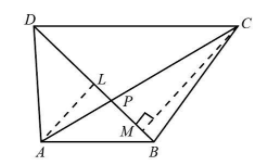
Diagonal AC and BD of a quadrilateral ABCD intersect each other at P. Show that$ar(APB) \times ar(CPD) = ar(APD) \times ar(BPC)$.


Answer
576.3k+ views
Hint:Here, we will solve the problem by finding the ratio of area of APB and APD and ratio of area of CPB and CPD and then equate both the equations to prove the given term.
Complete step-by-step solution
In triangle APB, the base is BP and the height is AL.
$ar(APB) = \left( {\dfrac{1}{2}} \right) \times BP \times AL$
In triangle APD, the base is DP and the height is AL.
$ar(APD) = \left( {\dfrac{1}{2}} \right) \times DP \times AL$
The ratio of both the triangles is,
$\begin{array}{c}
\dfrac{{ar(APB)}}{{ar(APD)}} = \dfrac{{\left( {\dfrac{1}{2}} \right) \times BP \times AL}}{{\left( {\dfrac{1}{2}} \right) \times PD \times AL}}\\
\dfrac{{ar(APB)}}{{ar(APD)}} = \dfrac{{BP}}{{PD}}
\end{array}$ ……(1)
Now, in triangle CPB, the base is BP and height is CM.
$ar(CPB) = \left( {\dfrac{1}{2}} \right) \times BP \times CM$
Now, in triangle CPD, the base is DP and height is CM.
$ar(CPD) = \left( {\dfrac{1}{2}} \right) \times DP \times CM$
The ratio of both the triangles is,
$\begin{array}{l}
\dfrac{{ar(CPB)}}{{ar(CPD)}} = \dfrac{{\left( {\dfrac{1}{2}} \right) \times BP \times CM}}{{\left( {\dfrac{1}{2}} \right) \times PD \times CM}}\\
\dfrac{{ar(CPB)}}{{ar(CPD)}} = \dfrac{{BP}}{{PD}}
\end{array}$ ……(2)
From equations (1) and (2).
$\begin{array}{c}
\dfrac{{ar(APB)}}{{ar(APD)}} = \dfrac{{ar(CPB)}}{{ar(CPD)}}\\
ar(APB) \times ar(CPD) = ar(APD) \times ar(CPB)
\end{array}$
Therefore, it is proved that $ar(APB) \times ar(CPD) = ar(APD) \times ar(CPB)$.
Note: While calculating area of APB and APD, height will be the same that is AL. While calculating the area of CPB and CPD, height will be the same that is CM.
Complete step-by-step solution
In triangle APB, the base is BP and the height is AL.
$ar(APB) = \left( {\dfrac{1}{2}} \right) \times BP \times AL$
In triangle APD, the base is DP and the height is AL.
$ar(APD) = \left( {\dfrac{1}{2}} \right) \times DP \times AL$
The ratio of both the triangles is,
$\begin{array}{c}
\dfrac{{ar(APB)}}{{ar(APD)}} = \dfrac{{\left( {\dfrac{1}{2}} \right) \times BP \times AL}}{{\left( {\dfrac{1}{2}} \right) \times PD \times AL}}\\
\dfrac{{ar(APB)}}{{ar(APD)}} = \dfrac{{BP}}{{PD}}
\end{array}$ ……(1)
Now, in triangle CPB, the base is BP and height is CM.
$ar(CPB) = \left( {\dfrac{1}{2}} \right) \times BP \times CM$
Now, in triangle CPD, the base is DP and height is CM.
$ar(CPD) = \left( {\dfrac{1}{2}} \right) \times DP \times CM$
The ratio of both the triangles is,
$\begin{array}{l}
\dfrac{{ar(CPB)}}{{ar(CPD)}} = \dfrac{{\left( {\dfrac{1}{2}} \right) \times BP \times CM}}{{\left( {\dfrac{1}{2}} \right) \times PD \times CM}}\\
\dfrac{{ar(CPB)}}{{ar(CPD)}} = \dfrac{{BP}}{{PD}}
\end{array}$ ……(2)
From equations (1) and (2).
$\begin{array}{c}
\dfrac{{ar(APB)}}{{ar(APD)}} = \dfrac{{ar(CPB)}}{{ar(CPD)}}\\
ar(APB) \times ar(CPD) = ar(APD) \times ar(CPB)
\end{array}$
Therefore, it is proved that $ar(APB) \times ar(CPD) = ar(APD) \times ar(CPB)$.
Note: While calculating area of APB and APD, height will be the same that is AL. While calculating the area of CPB and CPD, height will be the same that is CM.
Recently Updated Pages
Master Class 9 Social Science: Engaging Questions & Answers for Success

Master Class 9 Science: Engaging Questions & Answers for Success

Master Class 9 English: Engaging Questions & Answers for Success

Master Class 9 Maths: Engaging Questions & Answers for Success

Master Class 9 General Knowledge: Engaging Questions & Answers for Success

Class 9 Question and Answer - Your Ultimate Solutions Guide

Trending doubts
Which places in India experience sunrise first and class 9 social science CBSE

Fill the blanks with the suitable prepositions 1 The class 9 english CBSE

Write the 6 fundamental rights of India and explain in detail

Difference Between Plant Cell and Animal Cell

What is pollution? How many types of pollution? Define it

What is the Full Form of ISI and RAW





